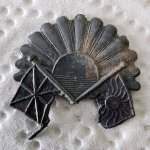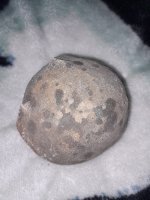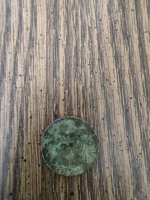Untouched Treasures in Watery Graves.
A programme is now under way to salvage shipwrecks and bring to surface the country's buried heritage
Little is it known that a good part of the country's heritage lies under the sea, lost and forgotten. Shipwrecks with untold treasures, priceless ceramics and an assortment of coins from various maritime nations lie untouched in their watery grave off the ancient ports of call such as Galle,
Mantai and Trincomalee. The most studied of these ports, Galle harbour is known to have as many as 26 maritime archaeological sites, some of which are in danger of being lost to posterity if action is not taken soon to recover them. A joint Sri Lankan-Dutch exercise known as the Mutual Heritage Programme is presently under way to salvage many of these lost treasures and bring them up for conservation in the recently established National Maritime Museum in Galle.
VOC shipwrecks
A number of VOC (Vereenigde Oost-Indische Compagnie, formed in 1602) shipwrecks are reported to taken place in Galle harbour, among them the Avondster, Hercules, Geinwens, Barbersteijn and Dolfijn. Work on the Avondster has already commenced and it will not be long before the rest of the wrecks come up for excavation.
Although Galle had become a major entrepot for international trade from about the 12th century, the entrance to the bay posed some threat to incoming and outgoing vessels in the olden days due to its many submerged reefs and rocks. A careful study of the Dutch records in the National Archives at Colombo and the VOC records in the Algemeen Rijksarchief in the Netherlands had revealed that of the VOC ships known to have sunk in or near the harbour, three were wrecked during the vessel's arrival or departure while two were sunk within the harbour, one by an explosion and the other after coming adrift from her anchor. For instance, the Hercules was wrecked in 1661 on the rocks near Closenberg on the north side of the bay as she departed from Galle with a cargo for Batavia. The Barbersteijn was wrecked in 1725 while sailing into the harbour while the Geinwens was wrecked in 1776 while sailing out of the harbour. These shipwrecks were detected in a survey carried out in 1996-97.
Underwater excavations
A joint Sri Lankan-Dutch team headed by Robert Parthesius is presently conducting investigations at the Avondster site and will shortly commence excavating the 34-metre jacht layer by layer. Among the items already recovered from the wreck are various jars, medicine bottles, part of a cannon axle and a human skull found below the main deck. Excavations underwater involved exposing the artifact by pumping out the sediment and depositing it elsewhere. The ship which is slanted on to a side on the seabed appears to have two decks while the masts seem to have broken off and been deposited elsewhere. The whole purpose of investigating the ship was to build a total picture so that a decision could be taken on how to bring it up. This could be done by removing the ship timber by timber and reconstructing it for display in Galle itself.
The historical research had revealed that the Avondster, Dutch for 'Evening Star' had been wrecked in a rather clumsy manner on the 23rd of June 1659. She had been anchored near the Black Fort after loading cargo for a trip to Negapatnam in India, but despite fine weather, slipped her anchor during the night and hit the coast north-east of the anchorage. The ship broke in two and was submerged in the soft sand below. An eye-witness account found in the Dutch records in Colombo tells how a sailor on deck discovered the vessel drifting and hastened to wake the skipper. The skipper was slow in making his appearance and by the time he ordered the warp anchor to be thrown out the ship had struck the coast and run aground.
Oldest finds
However, it is not only the VOC shipwrecks that have captured the attention of the excavation team. Other items too have been discovered, among them Indo-Arab stone anchors weighing 820 kg each found in the area of the Kamba Bandina Gala, a traditional mooring site for vessels lightering cargo to and from vessels to Galle. The wooden components of these have been carbon-dated to 1390-1640 which would make it older than any other artefact discovered in Galle to date.
The project will create a core of maritime archaeologists in Sri Lanka once the work on the Avondster is over. Seven Sri Lankan archaeologists have already been trained in this specialized field and have gained sufficient expertise in diving, retrieving artefacts and taking underwater photography. A group of ten conservators have gained experience in conserving the artefacts so retrieved while a few museum curators are also expected to be trained in the field of maritime archaeology shortly. The team's long-term plan is the establishment
of an underwater archaeology unit which will be able to undertake excavations underwater not only on shipwrecks, but also on other artefacts in our rivers and reservoirs.
Source : ASIFF HUSSEIN
Sunday Observer, 9 December 2001
Reference for illustrations 1 and 3 :
"Illustrations and Views of Dutch Ceylon (1602-1796)"
by R.K. de Silva and W.G.M. Beumer, Serendib Publication, London, 1988.
National Maritime Museum, Galle
The National Maritime Museum, Galle Located within the Fort of Galle in a colonial Dutch ware-house with imposing pillars. This museum displays the fauna & flora of the sea and the environment. Artefacts consist of preserved material and scale models of whales and fishes. Generally, all the resources of the sea are covered in this Museum.
It also shows in diorama form with life size models, the traditional methods of fishing. Some artefacts of under water archaeology are on display. An interesting experiment is the `walk-into-the sea' diorama, showing the natural coral beds, sea grass beds and deep sea fishes. Finally, one leaves the museum seeing the causes of sea pollution, coast erosion and methods used to combat these problems.
A programme is now under way to salvage shipwrecks and bring to surface the country's buried heritage
Little is it known that a good part of the country's heritage lies under the sea, lost and forgotten. Shipwrecks with untold treasures, priceless ceramics and an assortment of coins from various maritime nations lie untouched in their watery grave off the ancient ports of call such as Galle,
Mantai and Trincomalee. The most studied of these ports, Galle harbour is known to have as many as 26 maritime archaeological sites, some of which are in danger of being lost to posterity if action is not taken soon to recover them. A joint Sri Lankan-Dutch exercise known as the Mutual Heritage Programme is presently under way to salvage many of these lost treasures and bring them up for conservation in the recently established National Maritime Museum in Galle.
VOC shipwrecks
A number of VOC (Vereenigde Oost-Indische Compagnie, formed in 1602) shipwrecks are reported to taken place in Galle harbour, among them the Avondster, Hercules, Geinwens, Barbersteijn and Dolfijn. Work on the Avondster has already commenced and it will not be long before the rest of the wrecks come up for excavation.
Although Galle had become a major entrepot for international trade from about the 12th century, the entrance to the bay posed some threat to incoming and outgoing vessels in the olden days due to its many submerged reefs and rocks. A careful study of the Dutch records in the National Archives at Colombo and the VOC records in the Algemeen Rijksarchief in the Netherlands had revealed that of the VOC ships known to have sunk in or near the harbour, three were wrecked during the vessel's arrival or departure while two were sunk within the harbour, one by an explosion and the other after coming adrift from her anchor. For instance, the Hercules was wrecked in 1661 on the rocks near Closenberg on the north side of the bay as she departed from Galle with a cargo for Batavia. The Barbersteijn was wrecked in 1725 while sailing into the harbour while the Geinwens was wrecked in 1776 while sailing out of the harbour. These shipwrecks were detected in a survey carried out in 1996-97.
Underwater excavations
A joint Sri Lankan-Dutch team headed by Robert Parthesius is presently conducting investigations at the Avondster site and will shortly commence excavating the 34-metre jacht layer by layer. Among the items already recovered from the wreck are various jars, medicine bottles, part of a cannon axle and a human skull found below the main deck. Excavations underwater involved exposing the artifact by pumping out the sediment and depositing it elsewhere. The ship which is slanted on to a side on the seabed appears to have two decks while the masts seem to have broken off and been deposited elsewhere. The whole purpose of investigating the ship was to build a total picture so that a decision could be taken on how to bring it up. This could be done by removing the ship timber by timber and reconstructing it for display in Galle itself.
The historical research had revealed that the Avondster, Dutch for 'Evening Star' had been wrecked in a rather clumsy manner on the 23rd of June 1659. She had been anchored near the Black Fort after loading cargo for a trip to Negapatnam in India, but despite fine weather, slipped her anchor during the night and hit the coast north-east of the anchorage. The ship broke in two and was submerged in the soft sand below. An eye-witness account found in the Dutch records in Colombo tells how a sailor on deck discovered the vessel drifting and hastened to wake the skipper. The skipper was slow in making his appearance and by the time he ordered the warp anchor to be thrown out the ship had struck the coast and run aground.
Oldest finds
However, it is not only the VOC shipwrecks that have captured the attention of the excavation team. Other items too have been discovered, among them Indo-Arab stone anchors weighing 820 kg each found in the area of the Kamba Bandina Gala, a traditional mooring site for vessels lightering cargo to and from vessels to Galle. The wooden components of these have been carbon-dated to 1390-1640 which would make it older than any other artefact discovered in Galle to date.
The project will create a core of maritime archaeologists in Sri Lanka once the work on the Avondster is over. Seven Sri Lankan archaeologists have already been trained in this specialized field and have gained sufficient expertise in diving, retrieving artefacts and taking underwater photography. A group of ten conservators have gained experience in conserving the artefacts so retrieved while a few museum curators are also expected to be trained in the field of maritime archaeology shortly. The team's long-term plan is the establishment
of an underwater archaeology unit which will be able to undertake excavations underwater not only on shipwrecks, but also on other artefacts in our rivers and reservoirs.
Source : ASIFF HUSSEIN
Sunday Observer, 9 December 2001
Reference for illustrations 1 and 3 :
"Illustrations and Views of Dutch Ceylon (1602-1796)"
by R.K. de Silva and W.G.M. Beumer, Serendib Publication, London, 1988.
National Maritime Museum, Galle
The National Maritime Museum, Galle Located within the Fort of Galle in a colonial Dutch ware-house with imposing pillars. This museum displays the fauna & flora of the sea and the environment. Artefacts consist of preserved material and scale models of whales and fishes. Generally, all the resources of the sea are covered in this Museum.
It also shows in diorama form with life size models, the traditional methods of fishing. Some artefacts of under water archaeology are on display. An interesting experiment is the `walk-into-the sea' diorama, showing the natural coral beds, sea grass beds and deep sea fishes. Finally, one leaves the museum seeing the causes of sea pollution, coast erosion and methods used to combat these problems.






